Find your way
Follow us on Facebook

Follow us on Facebook

Managing the logistics efficiently will ensure that the Tour is carried out smoothly and provides a secure frame for the participants to challenge themselves, meet each other and learn. Think practical and try to anticipate as much as possible the group's needs and the situations you might face.
Here lies one of the biggest contradiction of the Heterotopia Tour: so far, we do rely on the plane most of the time for international transportation!
Why? Mainly because it is a substantial gain of time and money for the participants. But you can make different choices and encourage the participants to use more eco-friendly ways of transportation such as trains, carpooling or buses. Keep in mind that, if the Heterotopia Tour is financially supported by the Erasmus+ Program or by a public institution, only the means of transportation that can provide an invoice and a receipt might be eligible.
To book flights or international train or bus connections for your participants, you can visit online platforms (such as kiwi.com, kayak.com or interrail.eu) that you know of or ask the hosting organization for advice before actually looking for tickets. They might know the local possibilities and the best deals to reach the venue.
No matter how far the participants come from, if you host a Tour you will need to organize the arrival and departure of the participants and plan extra accommodation if needed before and after the Tour (cf. chapter below). In order to do so, we advice you to create an online chart on which all the info needed will be available.
From our experience, they should include at least:
We suggest you give access to this online chart to the coordinators of your international partners so that they can fulfill it with their participants after buying the tickets with them.
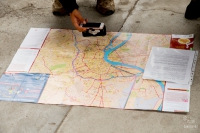 For the local transportation, you can try your best to limit your footprint by limiting the number of journeys during your stay to a minimum.
For the local transportation, you can try your best to limit your footprint by limiting the number of journeys during your stay to a minimum.
This requires good preparation and includes at least:
For any car journey, we strongly advise you to:
Remember that a participant might easily get lost (because they went to the toilets in a Café without telling anyone during your stay in town, or they turned at the last street corner to buy a sweet or better hear a street musician). To solve the problem, make sure they all have the phone numbers of your staff before any move and tell them when arriving at the venue where and when will be the meeting point you will leave from after the visit.
The arrival and departure time of the participants will vary significantly depending of their flights, train or bus connections. As organizers, you can decide to take care of the accommodation for the extra days of their stay and to figure how you will welcome them.
The challenge will be to make them feel confortable and welcome from the very first moment and to sustain this feeling over time, until they leave. In our experience, there are several options to do it, that all have pros and cons.
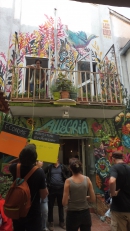 Option 1: a representative of your team meets and picks the participants up at the airport / train station / bus terminal. It will help build a relationship of trust and openess with the participants and reassure those who are not used to travelling, but it can be time-consuming if they all arrive at a different times.
Option 1: a representative of your team meets and picks the participants up at the airport / train station / bus terminal. It will help build a relationship of trust and openess with the participants and reassure those who are not used to travelling, but it can be time-consuming if they all arrive at a different times.
Option 2: If you can't be available to pick them up at the airport/station/terminal, we recommend to send to each person a “welcome pack” which explains how they can reach the place they will stay for the night and offers information on the city, the available transportation, the people they can contact in case of need, etc.
A nice additional proposition would be to offer to the participants to go on a tour of the city center or in some places that suits in their interest. It will help them feel at ease and connect with your team, the venue and the local community.
Option 1: host the participants in your homes and share a piece of your reality and lifestyle with them. It will help connect to each other and build a trusting relationship in an informal way, and will lay the foundations for community living, intercultural connections and deep communication in the following weeks.
Option 2: ask volunteers of your organization and people from your community to welcome the participants into their home. They might be really pleased to give you a hand, to feel part of the project and to meet people from elsewhere.
Option 3: rent some rooms in a nearby youth hostel where the participants can stay for a fair price. It will be lighter for you to organize than hosting them at home, but it can be difficult for some participants to cover the expense (given that, with Erasmus+ programs for example, the participants are usually responsible for paying all the expenses for transportation, accommodation and food for the extra days).
Whatever your choices, welcoming and hosting people before and after the Tour will require time, energy and availability. But a Heterotopia Tour is by essence about community living, sharing what we have, connecting with each other in a different way, and putting into practice what we believe in as far as possible. To be consistent, shouldn't we give our best from beginning to end ?
The Heterotopia Tour is an outdoors project. Some activities might occur within a building outside the eco-camp, but the living area will likely be set in a field and most of the activities will take place outdoors.
Usually, the participants sleep in tents, cook outside, enjoy their free time, wash themselves and fulfil their basic needs outdoors. It won't be such a pleasant experience for them if you don't design and equip the living area in a thoughtful way. From our experience, the eco-camp should include at least the following:
Provide shadow and protection from rain and wind for the cooking area, the food storage, the place the participants will gather to eat and at least one place to run activities. That way, you will save time and energy and prevent the participants to get tired because of the weather (too much sun, cold, etc.).
To increase the participants' comfort and well being, we suggest to provide them basic furnitures such as :
You should provide the basics (i.e. the kitchen area, the toilets, the showers, the shelter, the cleaning station) from the beginning but then you can dedicate a few workshops during the Tour to improve the living area with the help of the participants. It will help them connect with the venue and feel at home and can be a great team building activity in the first days.
Given how important a campfire can be for the group dynamic from our experience, we recommend you try your best to make it happen during the Tour. With the dry weather we have been experiencing lately during summer time in Europe, campfires might be prohibited in the area the Tour will take place. Yet, you might lift the ban if you secure the area where you intend to have the fire. Look for information from your local authorities about it: if you manage to offer a campfire, your living area will be the core of your camp and attract the whole group.
As the Heterotopia Tour is an outdoors project, you will depend on the weather… And you can never predict it for sure! Always consider that the climate will disturb your plans and that the weather will be the opposite of what you expect. To deal with it, you should always prepare:
Cold can also be an issue. Bring extra blankets and warm clothes with you in case some of the participants get cold at night. If you have the possibility to get your hands on some straw, feel free to offer some to the participants so they can put a layer under their tents. It will protect them from cold and wet weather, especially at night.
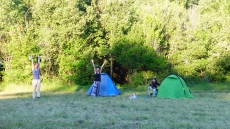 Keep in mind that the Tour might be the first outdoor living experience for some of the participants, and that people might be too optimistic regarding their resistance to cold or sunburns. Therefore make sure to bring extra sun-cream, hats, rain clothes, or even tents if possible : an unpredictable thunderstorm can put your participants comfort (and health) at risk if not anticipated. Nobody enjoys being stuck in wet clothes or covered in sunburns, it will impact the participants mood and motivation, thus the general atmosphere of the Tour.
Keep in mind that the Tour might be the first outdoor living experience for some of the participants, and that people might be too optimistic regarding their resistance to cold or sunburns. Therefore make sure to bring extra sun-cream, hats, rain clothes, or even tents if possible : an unpredictable thunderstorm can put your participants comfort (and health) at risk if not anticipated. Nobody enjoys being stuck in wet clothes or covered in sunburns, it will impact the participants mood and motivation, thus the general atmosphere of the Tour.
Food should never be a side aspect of the Tour. We strongly encourage you to buy local, organic, non-gmo, seasonal, unpackaged food as much as you can and, if possible from crops traditionally grown in the area.
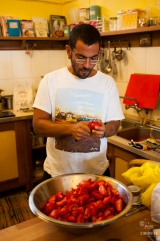 Try your best to get most of what you need from local organic farmers, open air markets and cooperative shops from the surroundings to both provide high quality food to the participants and support an ethical, local scale economy.
Try your best to get most of what you need from local organic farmers, open air markets and cooperative shops from the surroundings to both provide high quality food to the participants and support an ethical, local scale economy.
Ideally, we invite you to cook your own biscuits, jams, jellies, chutneys and preserves in advance as much as your time and creativity allows. It will be a nice way to promote self-sufficiency and an efficient tool to get the participants involved, as they will be encouraged to take part in the making process. In the end, it might help you to save money while providing high quality homemade products that gives an insight on what are the traditional ingredients available in the area and how they are proceeded.
If you feel comfortable with it, an additional challenge worth taking will be to encourage the participants to find (incr)edible wild plants from the local flora around the campsite (always keeping an eye on preserving biodiversity and caring about the participant's health and safety) to add to their meals. Given that wild picking is usually a new experience for most of the participants, we recommend you organize at least one workshop per Tour on this topic with the help of external facilitators, focusing on easy to find edible plants (such as nettle, plantago, rosmarin, salvia, thyme, etc.) that the participants can easily pick and cook during the Tour.
Always remember that food is strongly cultural and can easily become a source of tension. For example, some people are used to eating high protein meals and can feel underfed if they lack some products they are used to. It is important that you hear their needs and try to find a balance together to plan next meals and shopping trips. Generally speaking, the more you explain things to the participants and involve them in the purchasing and cooking process, the more you will avoid misunderstandings and complains.
Regarding the diet, we've been mainly preparing vegetarian food during the Tours in order to reduce our ecological footprint. Dealing with this new diet can be a big challenge for a person used to eating meat daily. For this reason, we advice you to offer at least one meal with meat a week to make the change easier.
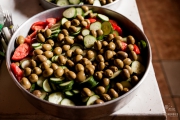 Each organization team should make their own choice regarding food diet, according to their ethics as long as every person's needs are also taken into consideration. This means that any specificity has to be recognized and respected: Gluten-free, lactose-free, sugar-free, vegan, hallal, kosher, food intolerances or wathever else diet. This can be a bit tricky sometimes, but it is decisive in making people feel safe and accepted for what they are.
Each organization team should make their own choice regarding food diet, according to their ethics as long as every person's needs are also taken into consideration. This means that any specificity has to be recognized and respected: Gluten-free, lactose-free, sugar-free, vegan, hallal, kosher, food intolerances or wathever else diet. This can be a bit tricky sometimes, but it is decisive in making people feel safe and accepted for what they are.
Cooking on a campsite requires a light and functional equipment. From our experience, your minimum cooking gear should include :
Those listed above are your “must-have”. Then you can add solar cookers, bike-blenders (for smoothies) or whatever you feel like adding that will be meaningful from a pedagogical point of view, specific to your traditional cooking slyle or funny to use.
We usually have no fridge during the Tours, which implies to divide up food supplies into 4 categories :
You need to plan your purchasing according to the category each food item belongs to. We usually buy most of the dry food beforehand in cooperative organic shops or from local producers we trust. For the fresh food, we usually plan ahead the trips to the farmers markets or local shops from each of the places we will visit during the Tour.
We strongly advice you to place an order for the food you need from the small shops or producers: those are not usual quantities and you can't afford to improvise. If you only get half of what you need from the shop because it is all they have, you will have to run somewhere else to get the rest when this time will be better used caring for your participants.
Knowing how to manage a budget, to purchase the right quantities of food or to cook for a group of 30 people are quite complex tasks. The Tour is a good opportunity for the participants to develop those skills.
To help them feel more comfortable and avoid mistakes, you can either let them free to choose whatever ingredients they want in the storage area to cook the meal (which can be a bit scaring for those who are not used to cook), either provide them a basket of food with the right quantity to prepare a meal (you will then let them free to decide what they want to do with the given ingredients).
Whatever the case, provide the participants easy guidelines for cooking various raw ingredients such as rice, pasta, chick peas: how many grams per person, how much water is needed, how long do you cook it, etc. Make sure they are explicit and simple enough for people who are not used to cooking and always within reach. You can also provide a book of recipes for those who don't feel comfortable or who prefer to cook with guidelines.
Keep in mind that the amount of food someone eats will vary by age, gender and personal preference: you will most probably have to adapt a bit your plan according to the needs and habits of your participants (you can't predict them before you meet).
Don't be afraid on the side of cooking a bit too much: you can't go wrong with having some leftovers around. If you store them well, they will be eaten on the next meal.
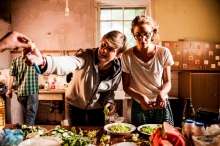 Taking into consideration that there are 3 meals per day (breakfast, lunch, dinner), that cooking for a group of approximatively 30 people takes time and that we want everyone to enjoy the various activities of the Tour, it makes sense not to leave the kitchen up to improvisation but to set up teams for cooking in advance.
Taking into consideration that there are 3 meals per day (breakfast, lunch, dinner), that cooking for a group of approximatively 30 people takes time and that we want everyone to enjoy the various activities of the Tour, it makes sense not to leave the kitchen up to improvisation but to set up teams for cooking in advance.
Depending on the Tour and the needs of the participants, those cooking teams can change shift either every day or every meal. Bearing in mind the abundant program filled with various activities and the duration of the Tour, each option has pros and cons:
A nice option for the selection of the teams (that should ideally never be composed of the same set of people) is that everyone writes their name on the daily program board under a specific breakfast, lunch or dinner at the beginning of the Tour or after every 5-6/7 days (when the group will change venue). It is a good idea to have additional discussions taking place every night after dinner to ensure there is enough people in each cooking team.
To reach the goal of providing nourishing food that meets everyone’s nutritional needs for each meql, we recommend you provide information to the participants about the various possibilities they have at their disposal to cook and that you support the least confident in their efforts to prepare meals.
As said before, you can decide either you prepare a basket with ingredients for the day or per meal (giving it to participants to use creatively), either you leave them total freedom to manage the amounts available for the whole tour or till the next shopping.
This means that each member of the group as mean to check what food supplies are available and has an idea of what the daily food budget for the group is.
In both cases, on shopping days, we recommend you bring to the market the cooking team for the day, so they can discover this aspect of the daily life as a group and get an insight on what types of budget constraints the group is dealing with. Thus, they can understand the choices that have been made by the organization team and assess the quantities of each product that can be bought with the budget for the day.
Regarding lunch and dinner, the cooking team should be informed of the number of people present, their specific diet(s) (vegan, halal, allergies) and the menu of the previous days, before starting putting ingredients together.
Food combinations for optimal nutrients absorption and adequate calorie/protein/carbs/etc intake will of course be central in the process to ensure people well-being and health. Nevertheless, don't confine yourself to nutritional data: Food is also about pleasure and being together. For this reason, encourage people to present the food before starting to eat (where the recipe is coming from, or any other story of the food the cooking team prepared), welcome diversity in the meals as much as possible and include sweets from time to time; they will always be appreciated.
(You can download HERE the Menu of the Tour that was held in Greece in September 2017 and HERE a document with the quantities of food it required).
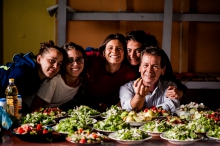 For any meal, have a look at what’s left from the meal before so there is no waste. Otherwise, a colorful, light and newly imagined and created recipe will most probably please everyone around the table.
Generally speaking, leave as much space as you can for creativity and to try to make every day a bit special: the smiles of the group will be your reward.
For any meal, have a look at what’s left from the meal before so there is no waste. Otherwise, a colorful, light and newly imagined and created recipe will most probably please everyone around the table.
Generally speaking, leave as much space as you can for creativity and to try to make every day a bit special: the smiles of the group will be your reward.
As for breakfast,it usually requires little to no planning, still it requires your care and attention : it is always a key moment of the day.
In order for the group to start the activities on time, ask first the breakfast team to wake up earlier than the group to prepare hot beverages (i.e. tea and coffee) by boiling water and pouring it into suitable containers at least half an hour before the breakfast is served. From the first days, the participants will get to know each other and will estimate and inform others on the exact quantity needed for each item (2 litres of coffee, 1 for tea, etc.).
On the table, offer as much variety as possible depending your local context and budget constraints. Ideally, provide at least coffee and tea (green and black), fresh fruits, bread, honey, tahini (instead of butter that cannot bear heat), marmalade, biscuits and dry fruits. To break routine, offer surprise food items from time to time such as yogurt, an omelet, pancakes, cheese, smoothie, etc. You might be surprised of the impact it can have on the people's mood!
